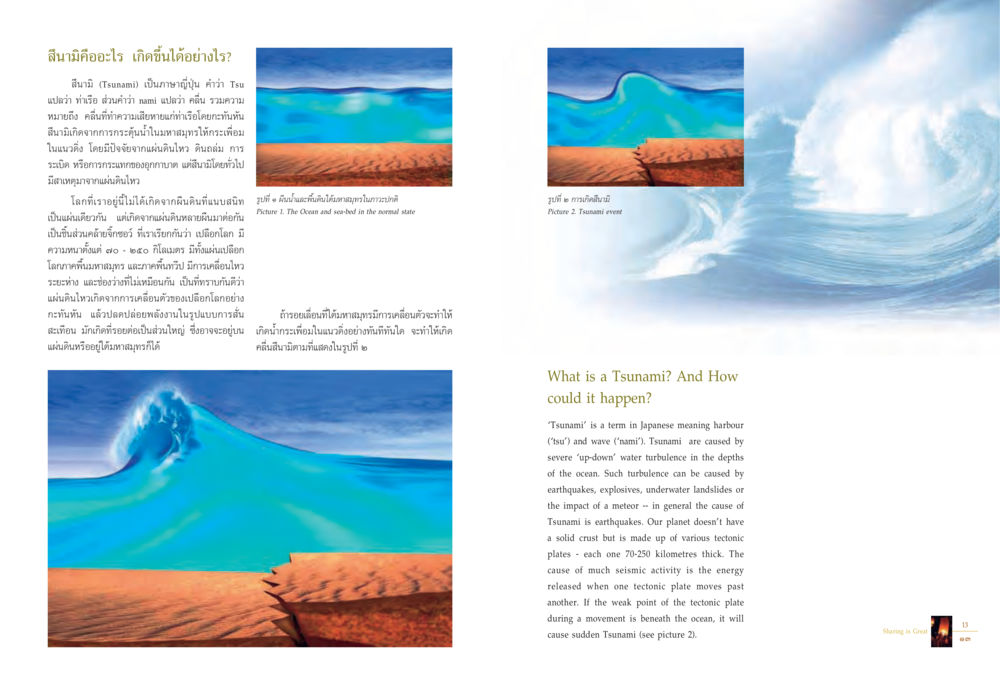แผ่นดินไหวและสึนามิในประเทศญี่ปุ่น : หน้า 8/103
Sharing is Great : หน้า 8/103 ศึกษาความสัมพันธ์ระหว่างแผ่นดินไหวและสึนามิในประเทศญี่ปุ่น รวมถึงผลกระทบและการเตรียมตัวรับมือที่จำเป็น
2 ครั้ง

สรุปเนื้อหา
ประเทศญี่ปุ่นเคยเผชิญกับแผ่นดินไหวรุนแรงที่นำไปสู่สึนามิขนาดใหญ่ การเตรียมตัวรับมือเป็นสิ่งสำคัญ โดยเฉพาะในพื้นที่ชายฝั่ง เช่น จังหวัดทางตะวันออกของญี่ปุ่น สึนามิเกิดจากการเคลื่อนไหวของ tectonic plates และมีความรุนแรงสูงมาก ซึ่งอาจส่งผลกระทบทั่วทั้งบริเวณที่กว้างออกไป คำว่า 'Tsunami' มาจากภาษาญี่ปุ่น หมายถึงคลื่นที่เกิดจากความเคลื่อนไหวของน้ำในทะเล ซึ่งส่วนใหญ่มาจากแผ่นดินไหว
หัวข้อประเด็น
-แผ่นดินไหวในญี่ปุ่น
-สึนามิและการเกิดขึ้น
-การเตรียมตัวรับมือกับสึนามิ
-ผลกระทบของการเคลื่อนไหว tectonic plates
-การศึกษาเกี่ยวกับสึนามิ
ข้อความต้นฉบับในหน้า
ประเทศญี่ปุ่นก็เคยเกิดแผ่นดินไหวในระดับรุนแรง ในอดีตเป็นต้น ซึ่งเป็นเหตุให้เกิดสึนามิครั้งรุนแรงขึ้น จนบางครั้งอาจมีความรุนแรงสูงสุดถึงระดับ 10–20 ซึ่งเป็นระดับสูงสุดของคลื่นสึนามิ และมีความเคลื่อนไหวรุนแรงและรวดเร็วมาก ซึ่งอาจกระจายคลื่นไปในบริเวณกว้างได้ เมื่อเทียบกับแผ่นดินไหวในระดับต่ำกว่า ที่สามารถอยู่ในแหล่งที่จุดเกิดได้มากกว่า
ทุกคนจะต้องเตรียมตัวรับมือให้ดี โดยเฉพาะอย่างยิ่ง หากอยู่ในบริเวณแนวชายฝั่งที่มีแนวโน้มจะเกิดสึนามิ เช่น จังหวัดชายฝั่งทะเลในฝั่งตะวันออกของประเทศญี่ปุ่น
วงกลมที่แสดงเป็นภาพคลื่นสึนามิในภาพด้านล่างนี้อาจเป็นภาพของคลื่นสึนามิขนาดใหญ่ที่กำลังพุ่งเข้าสู่ฝั่ง
ภาพที่ 1: คลื่นสึนามิในทะเลที่กำลังเคลื่อนตัวไปหาเกาะ
ภาพที่ 2: สึนามิในเหตุการณ์
What is a Tsunami? And How could it happen?
‘Tsunami’ is a term in Japanese meaning harbourn (‘tsu’) and wave (‘nami’). Tsunami are caused by severe ‘up-down’ water turbulence in the depths of the ocean. Such turbulence can be caused by earthquakes, explosives, underwater landslides or the impact of a meteor – in general the cause of Tsunami is earthquakes. Our planet doesn’t have a solid crust but is made up of various tectonic plates – each one 70-250 kilometres thick. The cause of much seismic activity is the energy released when one tectonic plate moves past another. If the weak point of the tectonic plate during a movement is beneath the ocean, it will cause sudden Tsunami (see picture 2).
หน้าหนังสือทั้งหมด
หนังสือที่เกี่ยวข้อง
Load More







































































































